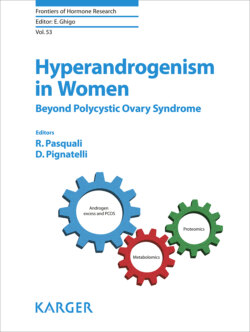Читать книгу Hyperandrogenism in Women - Группа авторов - Страница 14
Epigenetic Origins: Developmental Contribution to PCOS
ОглавлениеT and its biopotent metabolites are highly effective regulators of DNA methylation during fetal development. They enable the majority of phenotypic sexual differentiation in multiple organ systems and tissues, including the brain [51]. Increased or decreased DNA methylation can diminish or enhance, respectively, mRNA transcription of inherited gene variants [52]. Different patterns and degrees of DNA methylation at any single gene locus, however, are specific to each organ system or cell type in each individual. Unlike GWAS, therefore, there is less certainty as to how genome-wide methylation studies generalize beyond an organ system or cell type. DNA is differentially methylated in a variety of organ systems in women with PCOS [53, 54]. Gene-targeted DNA methylation studies of LHCGR have reported its hypomethylation in blood cells and subcutaneous (SC) adipose of women with PCOS, concurrent with increased LHCGR mRNA expression in these tissues [55–57]. If comparable DNA hypomethylation of LHCGR occurs in PCOS ovarian theca cells, it would likely increase androgenic responses to LH pulses, causing or amplifying ovarian hyperandrogenism. GWMS and bioinformatic pathway analyses have identified clusters of differentially methylated genes in PCOS women that may alter a variety of cellular functions, including immune response pathways (including autoimmunity), ovarian steroidogenic and metabolic functions, and cancer-related pathways [56, 58, 59]. Notably, there are commonalties between identified PCOS risk genes and differentially methylated genes in PCOS women, including LHCGR, RAB5/SUOX, AMH/AMHR2, and INSR, suggesting convergence of molecular pathogenic mechanisms around the same critical genes. Do similar mechanistic insights emerge from animal models of in utero female hyperandrogenism?
